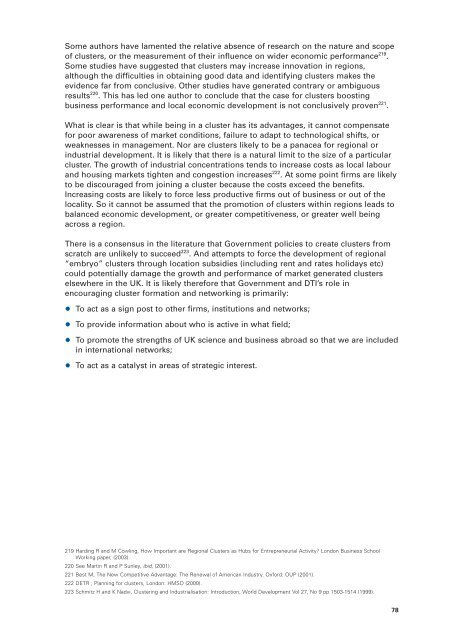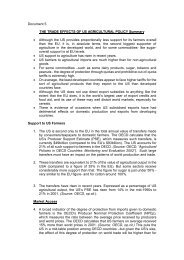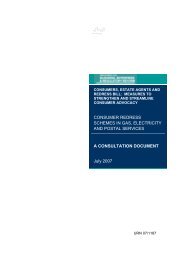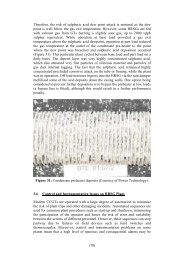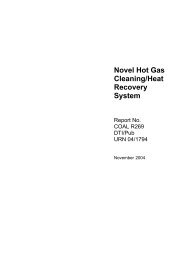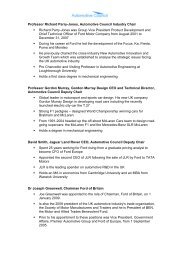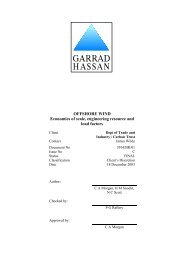Competing in the Global Economy – The Innovation Challenge
Competing in the Global Economy – The Innovation Challenge
Competing in the Global Economy – The Innovation Challenge
Create successful ePaper yourself
Turn your PDF publications into a flip-book with our unique Google optimized e-Paper software.
Some authors have lamented <strong>the</strong> relative absence of research on <strong>the</strong> nature and scope<br />
of clusters, or <strong>the</strong> measurement of <strong>the</strong>ir <strong>in</strong>fluence on wider economic performance 219 .<br />
Some studies have suggested that clusters may <strong>in</strong>crease <strong>in</strong>novation <strong>in</strong> regions,<br />
although <strong>the</strong> difficulties <strong>in</strong> obta<strong>in</strong><strong>in</strong>g good data and identify<strong>in</strong>g clusters makes <strong>the</strong><br />
evidence far from conclusive. O<strong>the</strong>r studies have generated contrary or ambiguous<br />
results 220 . This has led one author to conclude that <strong>the</strong> case for clusters boost<strong>in</strong>g<br />
bus<strong>in</strong>ess performance and local economic development is not conclusively proven 221 .<br />
What is clear is that while be<strong>in</strong>g <strong>in</strong> a cluster has its advantages, it cannot compensate<br />
for poor awareness of market conditions, failure to adapt to technological shifts, or<br />
weaknesses <strong>in</strong> management. Nor are clusters likely to be a panacea for regional or<br />
<strong>in</strong>dustrial development. It is likely that <strong>the</strong>re is a natural limit to <strong>the</strong> size of a particular<br />
cluster. <strong>The</strong> growth of <strong>in</strong>dustrial concentrations tends to <strong>in</strong>crease costs as local labour<br />
and hous<strong>in</strong>g markets tighten and congestion <strong>in</strong>creases 222 . At some po<strong>in</strong>t firms are likely<br />
to be discouraged from jo<strong>in</strong><strong>in</strong>g a cluster because <strong>the</strong> costs exceed <strong>the</strong> benefits.<br />
Increas<strong>in</strong>g costs are likely to force less productive firms out of bus<strong>in</strong>ess or out of <strong>the</strong><br />
locality. So it cannot be assumed that <strong>the</strong> promotion of clusters with<strong>in</strong> regions leads to<br />
balanced economic development, or greater competitiveness, or greater well be<strong>in</strong>g<br />
across a region.<br />
<strong>The</strong>re is a consensus <strong>in</strong> <strong>the</strong> literature that Government policies to create clusters from<br />
scratch are unlikely to succeed 223 . And attempts to force <strong>the</strong> development of regional<br />
“embryo” clusters through location subsidies (<strong>in</strong>clud<strong>in</strong>g rent and rates holidays etc)<br />
could potentially damage <strong>the</strong> growth and performance of market generated clusters<br />
elsewhere <strong>in</strong> <strong>the</strong> UK. It is likely <strong>the</strong>refore that Government and DTI’s role <strong>in</strong><br />
encourag<strong>in</strong>g cluster formation and network<strong>in</strong>g is primarily:<br />
• To act as a sign post to o<strong>the</strong>r firms, <strong>in</strong>stitutions and networks;<br />
• To provide <strong>in</strong>formation about who is active <strong>in</strong> what field;<br />
• To promote <strong>the</strong> strengths of UK science and bus<strong>in</strong>ess abroad so that we are <strong>in</strong>cluded<br />
<strong>in</strong> <strong>in</strong>ternational networks;<br />
• To act as a catalyst <strong>in</strong> areas of strategic <strong>in</strong>terest.<br />
219 Hard<strong>in</strong>g R and M Cowl<strong>in</strong>g, How Important are Regional Clusters as Hubs for Entrepreneurial Activity? London Bus<strong>in</strong>ess School<br />
Work<strong>in</strong>g paper, (2003).<br />
220 See Mart<strong>in</strong> R and P Sunley, ibid, (2001).<br />
221 Best M, <strong>The</strong> New Competitive Advantage: <strong>The</strong> Renewal of American Industry. Oxford: OUP (2001).<br />
222 DETR , Plann<strong>in</strong>g for clusters, London: HMSO (2000).<br />
223 Schmitz H and K Nadvi, Cluster<strong>in</strong>g and Industrialisation: Introduction, World Development Vol 27, No 9 pp 1503-1514 (1999).<br />
78


